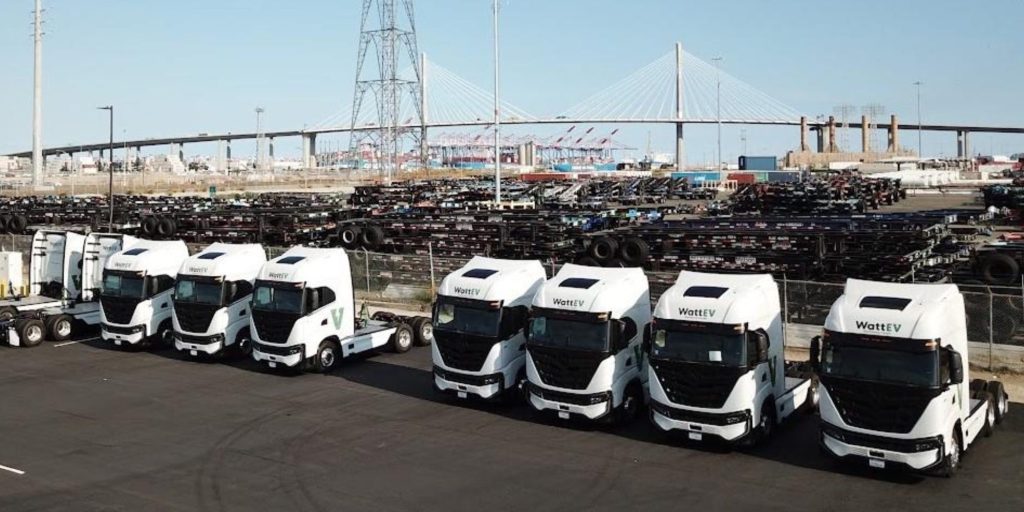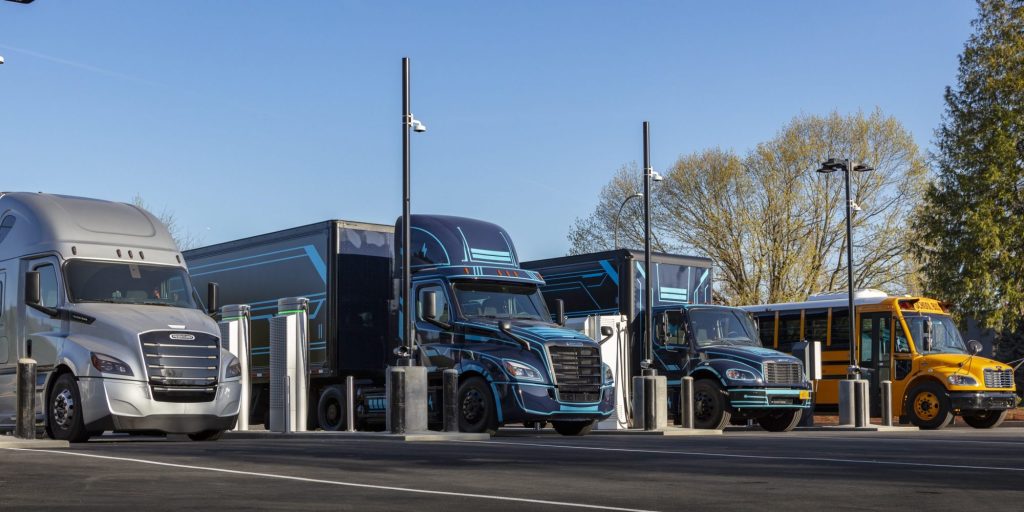
Trucking companies are currently suing the state of California in federal court, trying to protect their ability to continue forcing poison into your lungs – instead of saving billions of dollars across the state by shifting to electric trucks.
The lawsuit is over California’s Advanced Clean Fleets rule, which was finalized by the California Air Resources Board earlier this year.
The ambitious, world-first proposal sets high requirements for commercial fleet electrification and bans new diesel truck sales (not use) by 2036, with earlier timelines for more narrow applications. For example, drayage trucks, which bring freight from ports to distribution centers and are largely responsible for poor air quality in California’s Inland Empire, need to switch to all-electric purchases by the end of this year.
It’s a complement to California’s Advanced Clean Trucks rule, which was finalized in 2020 and focused more on the production side, ensuring that manufacturers would produce enough electric trucks for fleets to purchase once the fleets rule was implemented. Since then, it has been adopted by ten other states, as often happens with California clean air regulations.
And sure enough, as time came to finalize the fleets rule, progress had gone so well with ZEV truck availability that California felt confident setting high targets for the fleets rule.

The result is a rule that will save Californians $26.5 billion in health costs and will save fleets $48 billion in operational costs due to lower fuel and maintenance expense. Those health savings come from thousands of avoided deaths, hospital admissions and ER visits from heart and lung illnesses.
And that doesn’t even include other environmental benefits, like reducing noise pollution and protecting California’s wildlife and wilderness areas, sources of biodiversity and tourism dollars and important pollinators for California’s huge agricultural industry.
While lifetime costs are significantly lower for electric trucks, upfront costs can be higher – currently, most electric commercial vehicles cost 2-3x as much upfront as their non-electric counterparts, though that is expected to ease significantly within the decade. Current prices can result in sticker shock for fleets, but huge incentives are available both on the state and federal level.
For example, Daimler’s new RIZON Class 4-5 truck just qualified for a $60,000 incentive from the state of California (which is available to other brands as well), on top of the $40,000 federal incentive as part of the Inflation Reduction Act. Then there are further incentives available for some classes of vehicle, for example school buses which are almost free to school districts.
Instead of improving the rule, CTA sues
But despite all of those savings, a trade group representing truck operators called the California Trucking Association has decided not to engage in making the rule better, but has instead sued in federal court to permanently stop the state from protecting the health and pocketbooks of its residents, and even of the trucking companies it represents.
We spoke with Guillermo Ortiz with the Natural Resources Defense Council, who pointed out that this fleets rule was in the works for several years, and stakeholders were heavily engaged during that process. Even after the rule’s finalization, some industry sat down at the table with the state to tweak the regulation and come to a compromise.
The Engine Manufacturer’s Association, a separate trade group representing truck manufacturers (like Volvo and Daimler) which has made plenty of anti-electric statements themselves, originally opposed the rule. But it made a compromise with the state, which it calls the “Clean Trucks Partnership.” In exchange for some tweaks ensuring regulatory stability and a harmonization with federal low-NOx guidelines, the EMA now supports CARB.

Ortiz also pointed out that compliance with the rule has come faster than expected. CARB says that ZEV truck availability is roughly double projected 2024 requirements, and sales are about two years ahead of schedule – indicating that the rule could have even been stronger than it was.
So the CTA is complaining about a rule which fleets are already finding it easy to comply with. And instead of going the more mature route that the EMA did – trying to sit down at the table and come up with a workable solution – CTA instead jumped straight to federal court.
The choice to file in federal court is notable. It shows that the CTA likely hopes that the environment-hostile U.S. “supreme” court might eventually get a chance to issue yet another ruling that is hostile to human life, and to established US law, and that flies in the face of the wishes of the public. But then, it is unsurprising that a group, more than half of whom were appointed or confirmed undemocratically to irreversible lifetime terms with the help of millions of dollars worth of bribes from the oil industry, would feel unassailable on their mission to aid the industry that bought them their seats.
In addition the move to file in federal court is probably also intended to have a chilling effect on EPA’s upcoming “phase 3” truck regulations, which build further on its first update to truck rules in 21 years, finalized late last year.
What’s worse, it’s hard to find out which companies are members of CTA. The organization doesn’t publish a member list (the directory is private), so the only names the NRDC could find are from testimonials on its website. Which makes it difficult to find these trucking companies and address their concerns.
How the rule helps everyone – including the CTA
And the CTA’s lawsuit is against the interest of these trucking companies themselves – those $48 billion in operational cost savings would go into their pockets, not the manufacturers’.
We hear so much grousing about gas prices – which, even at today’s rates, are artificially low due to trillions in global fossil fuel subsidies in the form of ignored external costs – raising the price of goods. Yet when there is an opportunity to save $48 billion on the cost of shipping those goods, we see companies sue not to save that money. If fuel costs matter, this lawsuit doesn’t make sense.
And there is high public support for this transition as well, and of course there is. It would reduce pollution and the costs of shipping. It would likely improve public perception if the industry electrified. This could (and will) be a huge win for the industry, if they’d only see it.
On another front, it would help their employees too. These workers would get to drive and work around cleaner vehicles with less exhaust and vibration from big diesel engines, meaning less health problems for employees, more productivity, and more happiness. We’ve already heard of some truckers delaying retirement because electric trucks are so much easier on their body – important in a time when the trucking industry is dealing with a long-term driver shortage.
The same health benefits apply particularly to the low-income communities in which many of these ports and distribution centers are located. The Port of Long Beach/Los Angeles is a pretty desolate place, choked with exhaust from moving 40% of the US’ containerized traffic from the coast to California’s Inland Empire, which has some of the worst air quality in the US.

This is why drayage trucks are being targeted first for electrification, because the environmental justice air quality gains are outsized when electrifying that specific application. In discussions over the Advanced Clean Fleets rule, a diverse coalition including labor representatives joined the usual suspects (scientists, public health, environmental justice organizations, etc) in supporting the rule.
Ortiz pointed out to us that if the higher-up business leaders making decisions in the CTA had to live in these communities, or had to explain themselves to these communities, maybe they’d have more trouble passing along their talking points so uncritically. That $26.5 billion in health costs isn’t just a number – that’s real misery, and it’s a burden that is mostly borne by the communities that can handle it the least.
Those communities aren’t just writing checks to get out of this cost, they’re being forced into early retirement and disability, saddled with weekly doctor’s appointments, and filling up ERs. Their children are getting asthma and having their mental development stunted by pollution. That’s the actual cost here if the trucking companies prevail in this lawsuit, not just their own dollars which they could save if they dropped it.
Why do business orgs oppose improvements?
So, if everyone else understands that this transition is a good thing – manufacturers, laborers, accountants, the public, scientists, people with lungs, and so on – then what is CTA’s problem?
Sometimes regulation can have high costs and little benefit, but that isn’t the case here – the benefits have been calculated and they are massive, and the costs and process of implementation has been designed to be gradual and with significant incentives available. All the other entities listed above agree on these points.
And so, it seems to be another example of a business reflexively opposing any sort of regulation, even if that regulation is beneficial for everyone.
We saw this happen before – in California no less – when in 2016 virtually all car companies begged the EPA’s new oil-funded boss to reverse President Obama’s historic national fuel efficiency standard which represented an alignment between federal and California standards for the first time and would save the nation trillions of dollars.
With any foresight the car companies might have known that asking the fossil-industry lobbyists in charge of the EPA to destroy regulations would cause a difficult split market for automakers, but they fell victim to the big business compulsion to avoid regulations designed to help the public. Only after the fact did they realize their mistake and instead started lobbying the EPA to close the “Pandora’s Box” which they themselves had originally opened.
Luckily, California eventually won that fight, as we predicted it would. And good regulations continued on, despite the wasted effort to resist them.
Perhaps the CTA could learn something from the auto industry’s last boondoggle, and stop wasting time and money fighting against regulations that will save them money, and will save the lives of their employees and the public.
FTC: We use income earning auto affiliate links. More.



Comments